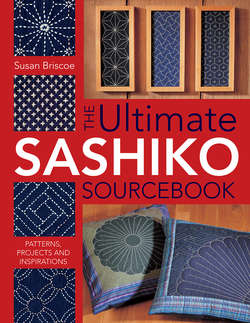Читать книгу The Ultimate Sashiko Sourcebook - Susan Briscoe - Страница 6
На сайте Литреса книга снята с продажи.
A SASHIKO HISTORY
ОглавлениеThe origins of sashiko stitching are lost in the mists of time. There are no written records of its real beginnings, no original surviving piece of work that can be conclusively dated or attributedto an individual or group. Born of necessity, sashiko was used and worn out, so very little early work remains. Decorative sashiko must have begun as someone repaired clothing, sewing tsukuroi sashi (darning sashiko), economically using undyed thread on dark indigo cloth and realizing the decorative possibilities in the stitches.
Late 19th-century man’s nogi (work coat) from Yuza-machi, Yamagata Prefecture showing raimon (spiral) through two layers of indigo cotton. Work clothes were cut from old kimono.
COLLECTION OF CHIEKO HORI, YUZA-MACHI
Second-hand clothes shop, c.1900. Lengths of striped and checked fabric are displayed in the centre, with children’s kimono and jackets on either side.
POSTCARD, AUTHOR’S COLLECTION
Sashiko evolved as a rural domestic craft in Japan during the Edo era (1615–1868), a time of increasing prosperity and peace after more than a hundred years of civil war. It made cloth stronger, improved its thermal qualities and recycled worn-out textiles – important at a time when all fibres were hand spun, hand woven and hand dyed in labour-intensive processes, from linen, hemp, ramie and other bast fibres. Fabric was remade into work wear, then into bags and aprons and finally into cleaning cloths, all with sashiko. By the Meiji era (1868–1912), sashiko was established as winter work in northern farming communities, when heavy snowfall restricted outside activities. Hand sewing was vital to a rural domestic economy and skill in sashiko was essential for a young girl wanting to make a good marriage. Girls and young women attended village needlework schools during the winter, when farm work was slack, where sashiko was passed down from hand to hand. Learning sashiko helped to instil values of patience and perseverance – essential qualities for a farmer’s wife.
In Japan, inspirations for sashiko are all around – work clothes drying against minka (farmhouse) walls; a farmhouse with irori hearth and latticed shoji screens; rice in striped rows – all near Yuza-machi, Yamagata Prefecture.
Tsukuroi sashi (darning sashiko) is shown in these two early 20th-century noragi (work coats) from Tohoku, heavily patched inside and out. Tsukuroi sashi was stitched by men and women. The darker indigo jacket was darned after it was made but the other is made from a patchwork of scraps with each section heavily stitched with plain sashiko in indigo thread before making up. Like patchwork quilts, antique sashiko may have fabric much older than the stitching.
ALL PICTURES THIS PAGE AUTHOR’S COLLECTION
Old country clothes – women planting rice and returning from the fields.
EARLY 20TH-CENTURY POSTCARDS, AUTHOR’S COLLECTION
Traditional bedding or futon – shikibuton for a mattress and kakebuton as a winter cover. Futongawa (futon covers) and lightweight kakebuton were sometimes made with sashiko. Note the yogi, a thickly padded quilt shaped like a gigantic kimono, and the zabuton (floor cushion).
EARLY 20TH-CENTURY POSTCARD, AUTHOR’S COLLECTION
Reusing textiles has a long tradition in Japan, for economic and spiritual reasons. A funzō-e kesa (Buddhist priest’s mantle) in the Shōsōin, the imperial repository at Nara in central Japan, is an early example. It belonged to Emperor Shōmu who abdicated in AD749 to become a monk. It is made from scraps of plain weave silk, resembling raw edge appliqué, with parallel lines of running stitch in purple silk thread. Unlike commoners’ sashiko, here the old cloth is meant to be seen. Funzō-e made from rags and discarded fabrics were a symbol of humility and the vow of poverty. Making kesa was an act of devotion and prayers were recited while working.
Urban fire-fighters’ protective clothing of the Edo period also used plain sashiko. Fire-fighting teams would pull down timber buildings to create a fire break rather than quench the blaze with water and sashiko gave some protection from falling tiles and timber. Hanten (half wear) jackets and helmets, made from many layers of cloth, were doused with water before use. Decorative, painted or dyed hanten linings resembled traditional tattoos. They were displayed by turning the hanten inside out after extinguishing a fire or during festival parades.
